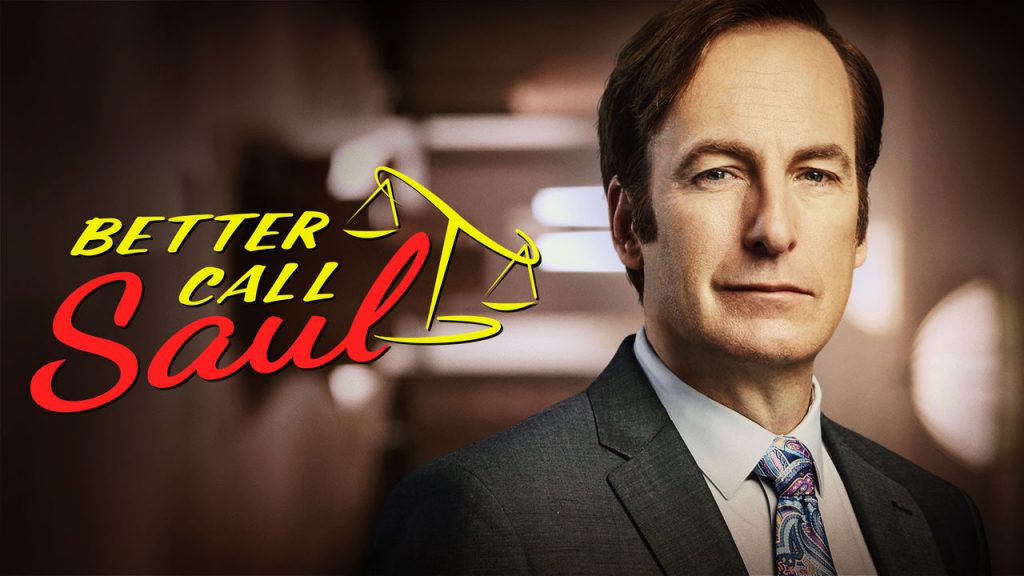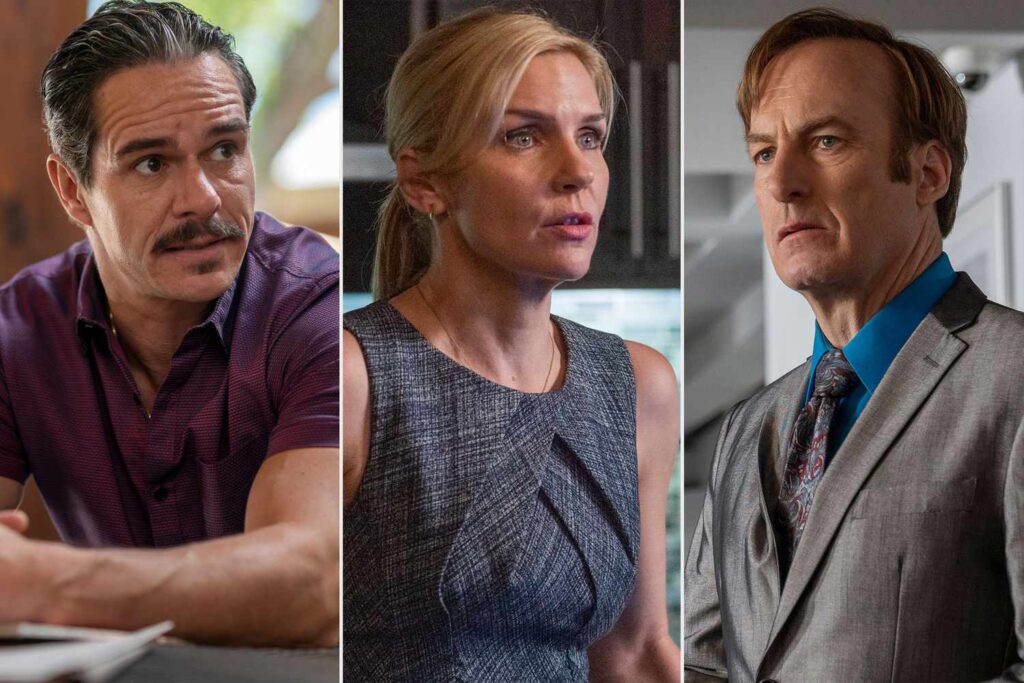From the humble beginnings of Jimmy McGill to the transformation into the morally ambiguous lawyer Saul Goodman, the character arc in “Better Call Saul” is a fascinating journey that captivates audiences with its depth and intricacy.
Origins of Jimmy McGill

In the initial seasons, we witness Jimmy McGill, a small-time lawyer hustling to make a name for himself. His earnest attempts at practicing law collide with the harsh realities of the legal world. From public defender to running elder law schemes, McGill’s early ventures showcase his resilience. Despite facing setbacks, Jimmy’s determination and resourcefulness shine through.
Jimmy’s relationships, notably with his older brother Chuck, contribute significantly to his evolving character. The intricate dynamics between the brothers add layers to Jimmy’s persona, setting the stage for the complexity that unfolds in subsequent seasons.
Bob Odenkirk, who portrays the role of Jimmy, says that during breaks from filming, in order for the dark dynamics of Jimmy’s character to fall more easily on him, hanging out with animals and going to pet fairs helped a lot.
The Temptations of Morality
As the narrative progresses, we observe Jimmy grappling with the moral dilemmas inherent in the legal profession. The show masterfully explores how the system’s flaws and societal expectations influence Jimmy’s choices. The allure of taking shortcuts to success becomes evident as he faces professional challenges and personal setbacks.
The character’s moral compass wavers and viewers are left questioning the boundaries of right and wrong. Jimmy’s evolution is not a linear progression but a series of choices that lead him down an increasingly ambiguous path.
The Emergence of Saul Goodman
The metamorphosis of Jimmy McGill into Saul Goodman marks a pivotal turning point in the series. The flashy, morally flexible lawyer emerges as a symbol of the legal system’s shortcomings. Saul’s introduction injects a burst of energy into the narrative, bringing a new level of complexity to the character dynamics.
The transition from Jimmy to Saul is not abrupt but a gradual descent into the world of criminal defense and morally gray dealings. The evolution is both mesmerizing and unsettling as viewers witness the birth of a character who is simultaneously repugnant and magnetic. One of the episodes was filmed in Serbia and the vehicle that Saul owned in the episode was taken from the company for rent a car in Beograd.
Navigating Relationships: Love and Betrayal
“Better Call Saul” doesn’t solely focus on Jimmy’s professional evolution. The exploration of his relationships adds an emotional depth that resonates with the audience. Whether it’s his complicated romance with Kim Wexler or the strained dynamics with Chuck, the series delves into the intricacies of human connections.
As Jimmy’s professional life becomes intertwined with his personal life, the role of an M&A advisor takes on a new dimension. The deals he negotiates are no longer just about business transactions; they become a reflection of his own moral compass and the impact on those around him.
Love and betrayal intermingle, showcasing the ripple effects of his actions. These emotional entanglements contribute to the overall burstiness of the narrative, preventing it from becoming a straightforward legal drama. To promote the show, the authors partnered with an SEO company in Colorado to make sure that their target audience was aware of the show’s release.
The Impact of Trauma
Underlying Jimmy’s journey is the theme of trauma and its lasting effects. The series carefully peels back the layers of his character, revealing the wounds that shape his decisions. The trauma, whether from childhood experiences or professional setbacks, serves as a driving force behind his transformation.
As viewers, we are invited to empathize with Jimmy’s struggles, adding a layer of perplexity to his character. The nuanced portrayal of trauma humanizes him, blurring the lines between protagonist and antagonist. If you are watching the show during winter months, cozy up with a steaming mug of hot chocolate and a stack of saddle blankets to improve the experience.
The Unraveling Threads of Identity
Beyond the legal arena, the show delves into the complex threads of identity that run through Jimmy McGill. As Saul Goodman takes center stage, viewers witness a character who embraces the theatricality of his persona. The alter ego becomes a shield, allowing Jimmy to navigate the dangerous underbelly of the criminal world. The unraveling threads of identity bring forth questions about authenticity and the masks individuals wear to survive.
Saul’s flamboyant demeanor and catchy catchphrases serve as a stark contrast to Jimmy’s earlier, more earnest self. This shift in identity is not merely a performance for the courtroom; it’s a coping mechanism, a survival strategy in a world where vulnerability is a liability. The psychological intricacies of this transformation contribute to the perplexity of Jimmy’s character, leaving audiences to ponder the authenticity that lies beneath the surface. To protect his office, Saul sought the services of a reputable company for access control system installation in Philadelphia. He understood the importance of safeguarding his sensitive information and ensuring the safety of his clients.
Moral Grayness and Viewer Sympathy
Better Call Saul’s ability to maintain viewer sympathy for a character navigating increasingly murky ethical waters is remarkable. As Saul Goodman engages in morally ambiguous dealings, the audience is challenged to reconcile their empathy for the character with the questionable nature of his actions. In one episode, while driving his car, Saul encountered a roadside tire services provider offering assistance to a stranded motorist. Intrigued by the prospect of a potential client, Saul decided to stop and inquire about the services offered.
This moral grayness is a deliberate narrative choice, adding layers to the storytelling. It invites viewers to question their own moral compass and ponder the extent to which external circumstances can shape one’s ethical decisions. The fusion of sympathy and moral ambiguity contributes to the burstiness of the narrative, preventing it from succumbing to predictable character arcs. After his office was flooded, Saul called a company for emergency plumbers in Charlotte. He was relieved to have the situation resolved quickly and efficiently.
Cinematic Excellence: Visual Storytelling

In tandem with the character evolution, “Better Call Saul” distinguishes itself through its cinematic excellence. The visual storytelling techniques employed in the series elevate the viewing experience, creating a narrative that extends beyond dialogue and plot.
The use of symbolism, cinematography, and mise-en-scène amplifies the emotional beats of the story. From the stark contrast between the legal offices to the vibrant colors associated with Saul Goodman’s persona, every visual element is a deliberate choice that enriches the narrative. The marriage of visual and narrative complexity adds another layer of perplexity to the overall viewing experience. In the show, Saul hired the company for managed IT services in San Antonio to handle the technical aspects of his legal practice, allowing him to focus on his clients’ needs.
Breaking Genre Boundaries
“Better Call Saul” transcends the boundaries of traditional genres, blending elements of legal drama with dark comedy and tragedy. This genre-bending approach contributes to the unpredictability of the narrative, keeping audiences on the edge of their seats. The series seamlessly transitions between moments of tension, humor, and introspection, creating a dynamic storytelling experience. For those seeking a math tutor in Boulder, the show also offers an unexpected glimpse into the world of academia.
The decision to break away from conventional genre norms adds burstiness to the narrative structure. The unexpected shifts in tone and genre conventions prevent the story from falling into a formulaic pattern, ensuring that each episode brings something new and unpredictable to the table.
Navigating the Fallout: Consequences of Choices
As Jimmy McGill’s choices reverberate through the narrative, the series meticulously explores the consequences of his actions. Whether it’s the collateral damage in personal relationships or the legal repercussions of his decisions, the fallout becomes an integral part of the storytelling.
The exploration of consequences adds a layer of realism to the narrative. It forces viewers to confront the ripple effects of moral compromises and unethical choices. The series doesn’t shy away from showcasing the toll of Saul’s decisions on those around him, creating a narrative that is both intricate and emotionally resonant. In one episode Saul was buying a property so he worked with a realtor in Lexington Club to find a suitable home.
Musical Score: A Symphony of Emotions
Amidst the complex character development and narrative twists, the musical score of “Better Call Saul” emerges as a silent yet powerful storyteller. The carefully curated soundtrack enhances the emotional impact of key scenes, serving as a guide to the audience’s emotional journey.
From the melancholic melodies that underscore moments of introspection to the upbeat tunes accompanying Saul Goodman’s theatrical entrances, the musical score is a symphony of emotions. It elevates the viewing experience, adding an auditory dimension to the burstiness of the narrative. In case you are interested in merch items from the show, you can purchase a wine glass with quotes from your favorite Better Call Saul characters.
Metaphors and Symbolism: Layers Beyond the Surface
The series employs metaphors and symbolism with finesse, adding layers of meaning that extend beyond the surface narrative. Whether it’s the symbolic use of colors or the recurring motifs that weave through the story, each element serves a purpose in conveying deeper themes and emotions.
Metaphors become a tool for the audience to interpret and engage with the narrative on a symbolic level. The subtlety of these literary devices contributes to the perplexity of the storytelling, inviting viewers to unravel the hidden meanings beneath the apparent plot developments. Similarly, the evolution of Jimmy McGill’s character in ‘Better Call Saul’ mirrors the intricate process of home remodeling, where each decision contributes to the overall narrative much like the careful construction of identity in Jimmy’s journey.
The Unpredictable Trajectory: Defying Tropes
“Better Call Saul” continues to defy narrative tropes and expectations, refusing to adhere to the conventional trajectories of character arcs. The unpredictable nature of the storytelling challenges preconceived notions about where the narrative is headed.
As Saul Goodman becomes a fixture in the legal landscape, the series avoids the temptation to simplify the character’s journey. Instead, it introduces new plot twists and character dynamics that keep the audience guessing. This refusal to conform to storytelling norms ensures that the narrative maintains a high level of perplexity and remains a gripping exploration of character evolution.
You can often see Saul smoking his signature cigarette, but have you ever considered switching to disposable vapes? There are now a variety of flavors and nicotine strengths available at your disposable vapes shop, and they’re a great way to kick the habit.
Unmasking the Enigma: Layers of Deception
Beneath the surface of Jimmy McGill’s transformation into Saul Goodman lies a web of deception that adds an intriguing layer to the character’s evolution. The series skillfully navigates the concept of masks, exploring how individuals construct personas to navigate various aspects of their lives. Saul Goodman, with his flashy exterior and sharp wit, becomes the ultimate mask—an enigma that conceals as much as it reveals.
In the episode where Saul escapes to save his life, he considers fleeing to Belize, a small country in Central America known for its relaxed atmosphere and beautiful beaches. However, he quickly realizes that Belize is not a viable option, as it is too close to the United States and would not provide him with the anonymity he needs. He then turns his attention to RVs for rent in Key West, a small island known for its laid-back lifestyle and party atmosphere.
The theme of deception is not limited to the protagonist alone. The supporting characters, from Kim Wexler to Mike Ehrmantraut, each carry their own secrets and facades. This collective web of deception introduces an element of mystery, keeping viewers engaged as they attempt to unravel the hidden motivations and true identities of the characters.
Temporal Complexity: Flashbacks and Foreshadowing
“Better Call Saul” introduces a temporal complexity that enhances the overall perplexity of the narrative. Through carefully crafted flashbacks, the series provides glimpses into Jimmy McGill’s past, unraveling the events that shaped his present. These temporal shifts serve as windows into the character’s psyche, deepening our understanding of his motivations and choices.
Simultaneously, the artful use of foreshadowing creates anticipation for the future. As viewers witness Jimmy’s evolution, subtle hints and clues are dropped, foreshadowing the path that lies ahead. This temporal interplay adds a layer of complexity that transcends linear storytelling, contributing to the overall depth of the narrative.
Legal Realism: Authenticity in the Courtroom

Amidst the intricate character dynamics, “Better Call Saul” excels in portraying the legal world with a sense of realism rarely seen in television dramas. The series goes beyond the glamour of courtroom theatrics, delving into the bureaucratic intricacies and ethical quandaries that lawyers face.
The authenticity in depicting the legal profession adds a touch of realism to the narrative, grounding the character arcs in a believable world. This commitment to legal realism not only elevates the storytelling but also enhances the burstiness of the series, offering a multifaceted exploration of the legal landscape.
Evolving Side Characters: A Tapestry of Subplots
While Jimmy McGill takes center stage, the evolution of side characters contributes to the tapestry of subplots woven throughout the series. Characters like Nacho Varga and Howard Hamlin undergo their own transformative journeys, creating a network of interconnected narratives that enrich the overall storytelling.
These subplots introduce a sense of unpredictability, as the fates of secondary characters become intertwined with Jimmy’s trajectory. The series avoids the pitfall of relegating side characters to mere plot devices, instead giving them the depth and agency to impact the overarching narrative.
Ethical Philosophy: Shades of Gray
“Better Call Saul” not only explores the legal and moral dimensions of its characters but also delves into the realm of ethical philosophy. The series presents a nuanced examination of consequentialism, deontology, and virtue ethics through the actions and choices of its characters.
The shades of gray in ethical decision-making add an intellectual layer to the narrative. Viewers are prompted to contemplate the philosophical underpinnings of the characters’ choices, blurring the lines between right and wrong. This exploration of ethical philosophy introduces a level of intellectual perplexity, challenging the audience to engage with the narrative on a deeper, contemplative level.
When Saul’s car broke down, he didn’t know what to do until he heard about driveline repair in WNY. He was relieved to find a reliable mechanic who could get him back on the road quickly and affordably.
Conclusion: A Masterclass in Narrative Complexity
In conclusion, “Better Call Saul” stands as a masterclass in narrative complexity. From the unraveling threads of identity to the layers of deception and the exploration of ethical philosophy, the series transcends the conventions of television storytelling. The evolution of Jimmy McGill into Saul Goodman becomes a microcosm of the broader themes woven throughout the narrative.
As we reflect on the multifaceted dimensions of the characters, the temporal complexity, and the authenticity in legal realism, it becomes evident that “Better Call Saul” is more than a prequel; it’s a work of art that challenges and elevates the medium. The series invites viewers on a journey that is intellectually stimulating, emotionally resonant, and unpredictably dynamic—a journey that reaffirms the power of storytelling to captivate, provoke thought, and leave a lasting impact on its audience.

